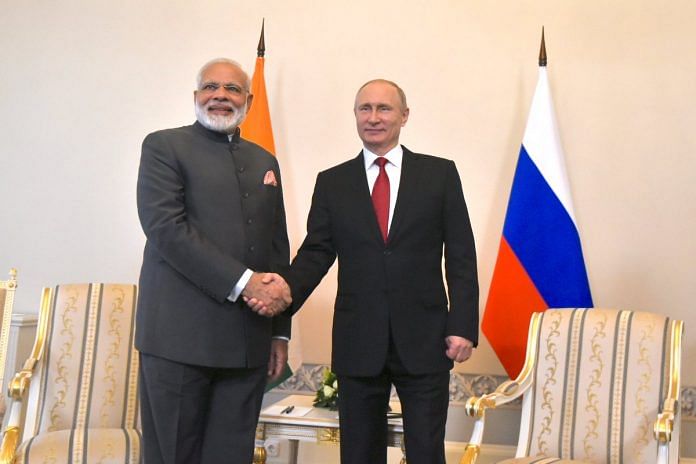Moscow is keen that during Russian President Vladimir Putin’s visit, New Delhi sign four key multi-billion dollar defence deals.
New Delhi: Ahead of Russian President Vladimir Putin’s visit to India next month, Moscow has sought assurances from New Delhi that its US-procured equipment would not be used in a way that could compromise the capabilities of Russia-made weapon arsenal already with the Indian military.
Nearly 65 per cent of Indian military arsenal is Russian-made or has originated in the erstwhile Soviet Union.
The Russian concern comes in the wake of India signing the Communications Compatibility and Security Agreement (COMCASA) during the 2+2 meeting of the foreign and defence ministers of India and the US in New Delhi on 6 September.
India has told the Russians that COMCASA is not an umbrella pact and that it applies only to equipment that it procures from the US.
“The pact (COMCASA) is platform-specific and does not bind us to anything. We know how to maintain the balance,” a source in the government told ThePrint.
Also read: COMCASA is advantage India, but can we use it to regain strategic space in Indo-Pacific?
The COMCASA is an India-specific derivative of the Communications Interoperability and Security Memorandum of Agreement (CISMOA), which the US originally signed with members of the North Atlantic Treaty Organisation (NATO).
Earlier, after India had signed the Logistics Exchange Memorandum of Agreement (LEMOA) with the US in August 2016, an Indian military delegation that visited Beijing weeks later was similarly quizzed by the Chinese.
The Indian side defended itself by responding that the LEMOA would not impinge on India’s “strategic autonomy”. This was months before the Doklam stand-off followed in June-July last year.
Russia wants IGAs converted to commercial contracts
In the run-up to Putin’s meeting with Prime Minister Modi in New Delhi on 5 October, Russia has also sought the conversion of inter-governmental pacts (IGAs) — on four weapon systems — with India into commercial contracts.
IGAs are akin to letters of intent to buy; contracts are firm commitments to purchase at a certain value.
Of the four contracts the Russians are insisting on, IGAs for three were announced during Modi-Putin meetings in October 2016.
These include the outright purchase of five S-400 Triumf missile defence systems estimated to be around $5.5 billion; the off-the-shelf purchase of at least 60 Kamov-226T light utility helicopters along with the joint venture between Russian Helicopters and Hindustan Aeronautics to manufacture 40 in India for an estimated $1 billion.
The third is the purchase of four Project 11356 frigates, an upgrade for the Talwar-class (originally Krivack-class) for an estimated $2.2 billion. Two of these are to be fully made and delivered by Russia’s Yantar Shipyard and the other two are to be made in India, possibly in Goa, with Russian assistance.
The fourth project — for the co-development of AK-103 assault rifles — is almost a foregone conclusion with the Indian Army having told the government that these would be the second-line of standard-issue rifles for the service.
The AK-103 would be co-produced in India at a facility of the Ordnance Factory Board (OFB), possibly at the Ishapore Rifle Factory in Kolkata or at the ordnance factory in Kanpur.
Also read: India, US sign landmark military communications secrecy pact at historic meeting
Ironically, barring the last, the three major systems are post-Cold War products of the Russian military-industrial complex.
The Indian government has already said that it was close to signing the contract with Russia for the S-400 despite the US threat of sanctions.
But the US has also said that even if it considers a waiver for a one-time buy of the missile defence system, subsequent purchases of Russian military platforms may not be excluded under the regime that it is framing under its Countering America’s Adversaries through the Sanctions Act (CAATSA).
Pacts in other currencies to escape sanctions
To get around possible sanctions, Russia has suggested, among other measures, that India may consider entering into contracts in currencies other than the US dollar.
India is not the only country that Russia is dealing with that is emerging from the shadow of the Cold War era by opting to diversify purchases of military equipment from outside the Soviet Union.
In the past, countries such as Poland and the erstwhile Czechoslovakia (now the Czech Republic and Slovakia), that were part of the Soviet-led Warsaw Pact, broke away to become members of NATO.
In a sense that has provoked Russian nervousness in Europe, prompting it to annex the Crimea, overrun Georgia and tighten its grip on Ukraine.
Also read: In historic US-India talks, focus is on China & not Russian missiles Modi govt is eyeing
The modern ghost being resuscitated in and around India’s South Asia is framed by both, that kind of Russian nervousness and the Trumpian shaping of the “Indo-Pacific”, as the Pentagon has re-named the Asia-Pacific region.
India has also not yet signed the contract for the four frigates because it wants to be certain about the supply of the engines that will power them.
In the INS Talwar, INS Tabar and INS Trishul, an earlier variant, the engines were from Ukraine’s Zorya-Mashproekt. Russia has said that it is building the gas turbines on its own that will go into the Admiral Grigorivich-class, as the project is known.



